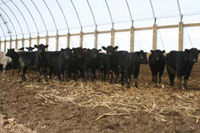We will cover in this 5 part series the major threats facing all cattle feeders, how they impact our operations and some solutions we are implementing in each area. Please feel free to comment on each segment as we go. The order in which we discuss these threats does not necessarily rank them as
each operation is different in how these threats apply to them, but each has an impact nonetheless.
Regulation
There are many types of regulation that can affect a business but we will focus here on environmental regulations of the EPA as it pertains to livestock operations under the Clean Water Act and the Clean Air Act.
Some background, in 2012 the EPA is operating with a $10 billion dollar budget. According to the justification for their 2012 budget allocation, they have 17,000 FTE employees and in the past 18 months have hired 200 “Special Enforcement Agents”. In recent days, they have to date successfully defended their practice of using flyovers as a method of enforcement. Earlier this spring an EPA regional director resigned under scrutiny of a comment he made regarding EPA enforcement tactics, “…We operate like the Romans used to…crucify the first 5 in any town and the rest become easier to manage”. Again in the justification for the 2012 budget, the top three water quality issues the EPA is targeting; 1. Raw sewage in water (I would agree). 2. Reduction of Urban runoff (here, here). 3. Livestock manure management (and we part ways). In specific, any NPDES permit holders, which would be any permitted livestock operation.
The EPA considers it’s work in the Chesapeake Bay to be successful and a model for other waterways. This is all fine and good until we start asking questions about the basis for determining what is good, what base level are we starting from? What is the natural state of the Chesapeake Bay waters? How do we determine between domestic animal wastes and wild animal wastes in terms of fecal coliforms and nutrient loads? Does this take into account the population of squirrels, bears, geese, deer, ducks and every other multitude of wild creature?
The Clean Water Act determines waters that fall under the federal umbrella to be “navigable” as defined below:
“Based on the agencies’ interpretation of the statute, implementing regulations and relevant caselaw, the following waters are protected by the Clean Water Act:
- Traditional navigable waters;
- Interstate waters;
- Wetlands adjacent to either traditional navigable waters or interstate waters;
- Non-navigable tributaries to traditional navigable waters that are relatively permanent, meaning they contain water at least seasonally; and
- Wetlands that directly abut relatively permanent waters”.
This by no means is meant to be comprehensive the long and short of it is that the EPA continues to fight for more jurisdiction over what can be determined as “waters of the State”. Note that, currently groups that do not think the EPA is doing enough to protect water resources sue the agency 3 times more than those being regulated.
On the front of air quality, the EPA has stated as its number 2 target is “particulate matter” which is a fancy way of saying dust. This should not only be of concern to those in the livestock industry but all of rural America. Dust a fact of life in rural areas. Gravel roads or most any field operation creates dust. Creating regulation about the control of dust will most definitely create unnecessary hardship for the vast majority of this great nation.
This information brings about the certainty that the rules that affect how we do business in the future will not become more lenient but more stringent. As we plan and prepare our operations for the future, we must consider not only the regulation as they stand today but the spirit of the law and the mentality of the regulatory agencies we are dealing with. Do not trade one pollution for another ie runoff control for odor. Does what I am doing to satisfy the regulatory agency improve the profitability of my operation or just meet requirements? We will discuss this aspect more in weeks to come.
Don’t Track it in the House….We Got Ya Covered.

